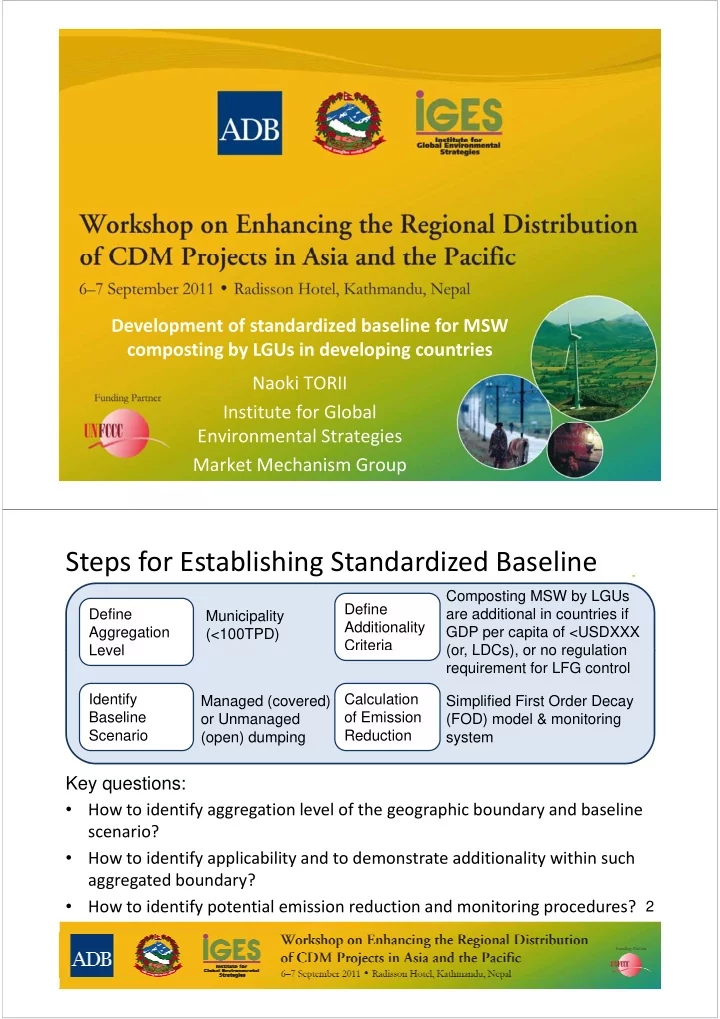

Development of standardized baseline for MSW composting by LGUs in developing countries Naoki TORII Institute for Global Environmental Strategies Market Mechanism Group Steps for Establishing Standardized Baseline Composting MSW by LGUs Composting MSW by LGUs Define Define are additional in countries if Municipality Additionality Aggregation GDP per capita of <USDXXX (<100TPD) Criteria Level Level (or LDCs) or no regulation (or, LDCs), or no regulation requirement for LFG control Identify y Calculation Managed (covered) g ( ) Simplified First Order Decay p y Baseline of Emission or Unmanaged (FOD) model & monitoring Scenario Reduction (open) dumping system Key questions: • How to identify aggregation level of the geographic boundary and baseline scenario? • How to identify applicability and to demonstrate additionality within such aggregated boundary? t d b d ? • How to identify potential emission reduction and monitoring procedures? 2
Aggregation level and baseline scenario • How far to aggregate = Proximity of the baseline scenario How far to aggregate = Proximity of the baseline scenario. Aggregated boundary • Identify types of the major Prj Prj di disposal practice which can l i hi h Prj Prj Prj … Prj be deemed as baseline scenario Prj Certain extent of the for a selected boundary. baseline similarity • Within a boundary not all the baseline conditions are the Within a boundary, not all the baseline conditions are the same (for the purpose of wider application). • Typical waste disposal scenarios in developing countries are • Typical waste disposal scenarios in developing countries are identified: Managed/Unmanaged dumping. • Plus, depth of the site (<5m or not) is to be determined per Pl d th f th it ( 5 t) i t b d t i d project site as it differentiates baseline emission. 3 Define additionality criteria & applicability • As the target case is “Municipal solid waste composting project g p p g p j by LGUs”, AMS ‐ III.F. is referred. Typical alternative scenarios in CDM AMS ‐ III.F. 1 Cases implemented without CDM revenue • According to the examples from g 2 Incineration (for energy generation) 2 Incineration (for energy generation) the registered CDM projects, 3 Landfill with methane capturing (for flaring or power generation) alternative scenarios areconvergent 4 Conversion to pellets Conversion to pellets into project implementation without 5 Continuation of baseline practice (disposal of waste in landfill) CDM or continuation of current practice. • Common barriers are identified for those projects. • Existence of such barriers and obstacles therefore continuation of the current practice is deemed highly likely scenario. • Thus, composting project by LGUs would not occur as BAU and is deemed additional under certain conditions which set out 4 applicability criteria (= positive listing).
Calculation of ER and monitoring ER = ER y 16 y k y x k φ * 1 - OX * * * * * * * * 1 * BE F DOC MCF W DOC e j e j GWP_CH , , , CH4 SWDS y 12 12 f j x j 4 1 x j - PE PE PE PE , , , y y transp y power y comp • Simplified equation for ER calculation • Simplified FOD model • IPCC default values are thoroughly utilized • PPs estimate their BE simply choosing conditions of the project site (i.e. managed or unmanaged, depth of the site, type of baseline waste disposal d d d th f th it t f b li t di l practice, climate and region) and inputting the amount of organic waste • Ex ‐ post monitoring on “the amount of organic waste type” and “PE Ex post monitoring on the amount of organic waste type and PE (PE y,transp , PE y,power , and PE y,compost )” 5 5 5 Conclusion • PPs are benefited from simpler & objective procedures Positive listing is recommended for easier implementation of CDM projects • Further, the CDM experience shows that sampling approach for • estimating waste composition creates barriers for project implementation as the specific numbers of sampling is not defined in the tool (i e minimum 4 times) Definition of such measures can lead the tool (i.e. minimum 4 times). Definition of such measures can lead to easier implementation by PPs as well as verification by DOEs • To solve a dilemma in keeping GHG emission real and credible while To solve a dilemma in keeping GHG emission real and credible while aggregating and generalizing baselines and project scenario, additionality determination, and emission reduction calculation, e.g. annual review on the baseline practice and gradual transition for de ‐ centralized approach (i.e. f ( country specific parameters) can be recommended • • This will require thorough data collection As such required capacity This will require thorough data collection. As such, required capacity development and awareness rising in host countries are important 6 6 6
Recommend
More recommend